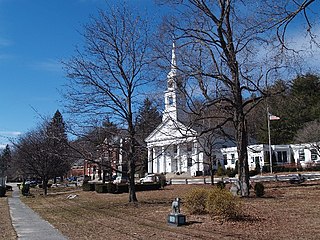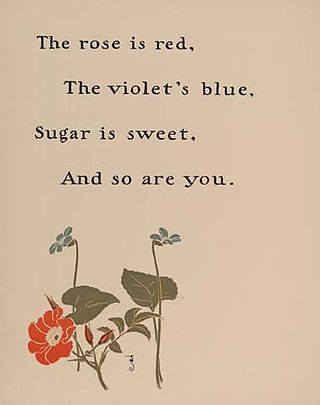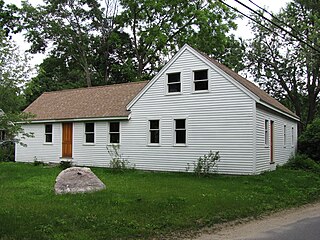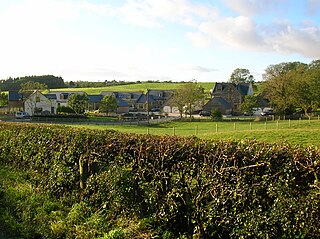
A nursery rhyme is a traditional poem or song for children in Britain and many other countries, but usage of the term dates only from the late 18th/early 19th century. The term Mother Goose rhymes is interchangeable with nursery rhymes.
"Twinkle, Twinkle, Little Star" is an English lullaby. The lyrics are from an early-19th-century English poem written by Jane Taylor, "The Star". The poem, which is in couplet form, was first published in 1806 in Rhymes for the Nursery, a collection of poems by Taylor and her sister Ann. It is now sung to the tune of the French melody "Ah! vous dirai-je, maman", which was first published in 1761 and later arranged by several composers, including Mozart with Twelve Variations on "Ah vous dirai-je, Maman". The English lyrics have five stanzas, although only the first is widely known. The song is in the public domain.

Sudbury is a town in Middlesex County, Massachusetts, United States. At the 2020 census, it had a population of 18,934. The town, located in Greater Boston's MetroWest region, has a colonial history.

Sterling is a town in Worcester County, Massachusetts, United States. The population was 7,985 at the 2020 census.

"Little Bo-Peep" or "Little Bo-Peep has lost her sheep" is a popular English language nursery rhyme. It has a Roud Folk Song Index number of 6487.

Sarah Josepha Buell Hale was an American writer, activist, and editor of the most widely circulated magazine in the period before the Civil War, Godey's Lady's Book. She was the author of the nursery rhyme "Mary Had a Little Lamb". Hale famously campaigned for the creation of the American holiday known as Thanksgiving, and for the completion of the Bunker Hill Monument.

"Ladybird, Ladybird" is the first line of an English-language nursery rhyme that also has German analogues. It is included in the Roud Folk Song Index as number of 16215.

"The Man in the Moon Stayed Up Too Late" is J. R. R. Tolkien's imagined original song behind the nursery rhyme "Hey Diddle Diddle ", invented by back-formation. It was first published in Yorkshire Poetry magazine in 1923, and was reused in extended form in the 1954–55 The Lord of the Rings as a song sung by Frodo Baggins in the Prancing Pony inn. The extended version was republished in the 1962 collection The Adventures of Tom Bombadil.
"Miss Susie", also known as "Hello Operator", "Miss Suzy", "Miss Lucy", and many other names, is the name of an American schoolyard rhyme in which each verse leads up to a rude word or profanity which is revealed in the next verse as part of an innocuous word or phrase. Originally used as a jump-rope rhyme, it is now more often sung alone or as part of a clapping game. Hand signs sometimes accompany the song, such as pulling on the bell in the first verse or making a phone gesture in the second.

"Roses Are Red" is the name of a love poem and children's rhyme with Roud Folk Song Index number 19798. It has become a cliché for Valentine's Day, and has spawned multiple humorous and parodic variants.
A children's song may be a nursery rhyme set to music, a song that children invent and share among themselves or a modern creation intended for entertainment, use in the home or education. Although children's songs have been recorded and studied in some cultures more than others, they appear to be universal in human society.
Nationality words link to articles with information on the nation's poetry or literature.

"Little Orphant Annie" is an 1885 poem written by James Whitcomb Riley and published by the Bobbs-Merrill Company. First titled "The Elf Child", the name was changed by Riley to "Little Orphant Allie" at its third printing; however, a typesetting error during printing renamed the poem to its current form. Known as the "Hoosier poet", Riley wrote the rhymes in 19th-century Hoosier dialect. As one of his most well known poems, it served as the inspiration for the comic strip Little Orphan Annie, which itself inspired a Broadway musical, several films, and many radio and television programs.

The Sawyer Homestead was a historic house at 108 Maple Street in Sterling, Massachusetts. With an estimated construction date of 1756, the house was one of Sterling's oldest surviving structures, before it was destroyed by an arsonist in 2007. It was also notable as the birthplace of Mary Sawyer, who alleged she was the subject of the American children's nursery rhyme "Mary Had a Little Lamb". The house was listed on the National Register of Historic Places in 2000. The Sawyer family, whose descendants still own the property, have had a reproduction of the house built on its site.

The Wayside Inn Historic District is a historic district on Old Boston Post Road in Sudbury, Massachusetts. The district contains the Wayside Inn, a historic landmark that is one of the oldest inns in the country, operating as Howe's Tavern in 1716. The district features Greek Revival and American colonial architecture. The area was added to the National Register of Historic Places in 1973.
Liberia; or, Mr. Peyton's Experiments is an 1853 novel by Sarah Josepha Hale, the author of the nursery rhyme "Mary Had a Little Lamb", who wrote the novel under the name of Sara J. Hale.

Two Souls in One is the debut album by American saxophonist George Braith recorded in 1963 and released on the Blue Note label.
Norah Montgomerie, born Norah Mary Shargool, was a British folklorist, illustrator and writer.

Handsome Nell was the first song written by Robert Burns, often treated as a poem, that was first published in the last volume of James Johnson's Scots Musical Museum in 1803 (No.551) with an untitled tune. Burns recorded in holograph on page three of his first Commonplace Book that he wrote the song or Rhyme at the age of only fifteen whilst living at Mount Oliphant Farm, it is regarded as his earliest production, inspired by a farm servant aged fourteen, named either Nelly Kilpatrick or Nelly Blair. Some confusion exists as he also gave his age as 16 in his autobiographical letter to Dr. Moore; the autumn of 1774 is generally accepted.

The Redstone School is an historic one-room school located in Sudbury, Massachusetts. Built in 1798, it is believed to be the school which Mary Tyler took her lamb to in the nursery rhyme "Mary Had a Little Lamb".















